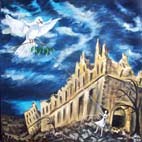Cassino, with Rocca Janula, or Castle Hill.

Cassino, with Rocca Janula, or Castle Hill.
Monte Cassino shrouded
These works, together with the one shown in the previous blog post, were painted for the 2012 edition of Legato and will be shown again this year.
Based on photographs of the area after the bombing of both the town and the abbey, these studies, apparently in shades of grey, have in fact many colours within them. The colours are subdued, reflecting the sombre theme. In contrast, the bright poppies both recall the lives lost and give a message of a new start, as the poppies in the fields appear each year no matter what the land use, or how difficult the season.
After painting these I found myself in a difficult, sad space; too much contemplation of death and the loss of hope for individuals, of sacrifice and of suffering both on the battlefield and for the waiting families, is not good for an artist. In response to this I painted a large, more positive painting of Monte Cassino, showing the land as it is today, fertile, alive, with no hint of the tragedy of the battles in the painting. (This will be shown in another post).
If poppies are for commemoration, then let us paint them with reverence, let us remember with respect and honour, but let us also move forward in peace.
Kay de Lautour, artist and curator of Legato.


























